The following post is part of a series of analyses on drug policy challenges facing Colombia, and how particular approaches may affect prospects for building a sustainable peace in the country. You can read Adam Isacson’s analysis here and analysis by Beau Kilmer and Greg Midgette here.
The dramatic expansion of coca cultivation in Colombia recently is putting significant pressure on its government to reduce production. That pressure comes from rightist politicians in Colombia, drug-war-focused politicians in the United States, and international counternarcotics bodies. Yet prematurely eradicating coca and inappropriately designed anti-drug efforts can spell disaster for Colombia’s peace deal with the Revolutionary Armed Forces of Colombia (FARC), as well as for the broader social peace the country has a chance to achieve.
Colombia’s estimated cocaine output increased by 37 percent since 2015, to an all-time high of 710 tons in 2016. There are many hypotheses as to why: the FARC encouraging farmers to grow more coca since the cocalero protests of 2013; farmers being aware of the Colombian government’s plan under the FARC peace accord to compensate farmers for switching to legal crops; the end to aerial spraying amidst concerns that the spraying agent glyphosate may be carcinogenic; the lack of alternative livelihoods in place (since prior coca suppression was achieved through eradication or interdiction only); and the collapse of commodity prices, such as timber and gold, which some cocaleros had switched to extracting.
In response, the Colombian government and the post-peace-deal-FARC jointly declared this January a highly ambitious goal of eliminating 50,000 hectares of coca cultivation this year through a voluntarily-compensated “crop substitution” effort—an old terminology for what will hopefully become a more well-rounded rural development. Between the end of January and late March, some 58,000 families whose 2016 coca plots covered about 49,000 hectares have signed up. After they eradicate their coca fields, they are to receive compensation and government assistance in getting titles for their land. The government also plans to eliminate another 50,000 hectares of coca through forced, non-compensated eradication, such as in Colombia’s national parks and indigenous reserves.
Prioritizing coca suppression in protected areas is praiseworthy. But the compensated voluntary eradication and crop substitution scheme is fraught with many pitfalls and dangers.
Wrong Sequencing Again?
The history of alternative livelihoods in Colombia, is mostly a history of failures. Sequencing problems are one of many reasons: Officials have insisted on eradication, often down to zero coca, before alternative livelihoods are even initiated. Yet the “eradication first, alternative livelihoods second” approach has never worked in Colombia, even with the best of intentions and much effort, such as in Nariño. That’s because alternative livelihoods often take years of multifaceted effort to become anchored and to start producing sufficient and sustainable income. Insisting on eradication as a precondition—from which no sufficient income materializes—sours farmers on the entire effort.
Compared to similar, prior efforts in Colombia, the level of compensation is now much higher: $7,800 in the first year, with perhaps as much as $12,000 per family within two years, and with a hefty total of $340 million dedicated to alternative livelihoods. Compensation during prior efforts, including programs such as Guardabosque for eliminating coca cultivation in national parks, often amounted to a few hundred dollars per family. That perhaps covered a family’s food security for a few months, but did not leave enough for the necessary investments into legal livelihoods. But even with the higher compensation, insisting on a prior eradication of coca as a precondition for development assistance is risky and counterproductive. Fortunately, there appears to be at least some wiggle room, in which communities aren’t required to eradicate all of their coca before receiving any compensation; even so, a total of two years is too short.
Tolerating farmers’ cultivation of a small part of their land with coca for some years would enable the development of alternative livelihoods. Such a small plot of coca can provide a family with critical insurance while it tries to convert to an alternative and cushions its income against the highly fluctuating prices of legal crops. Bolivia’s uno-cato policy, highly controversial but effective, serves as an example. In Washington, of course, Bolivia continues to be viewed as a pariah, including because it recently doubled the amount of land on which farmers can legally cultivate coca for traditional use, even though leakage from the legal cultivation into the illegal cocaine trade persists.
Another typical mistake is over-focusing on the replacement crop, such as coffee or cacao, and under-focusing on development-support infrastructure and value-added chains. Developing off-farm job opportunities and investing in basic human development programs for cocaleros and potential cocaleros is also essential.
The Thailand Model
Thailand is widely and deservedly recognized as the model for how to reduce illicit crop cultivation through comprehensive alternative livelihood programs. It was also among the first countries to learn in the 1960s and 1970s that in order to defeat insurgencies, punitive suppression policies toward drug cultivation needed to be halted.
There are several elements to Thailand’s success. Eradication policies toward drug crops were halted during its counter-insurgency operations and during several post-conflict years, while alternative livelihood programs were initiated in poppy-growing areas. Eradication was suspended until after alternative livelihood efforts generated sufficient income for opium poppy farmers—not before or concurrently, as often prescribed in international counter-narcotics efforts. The opium poppy thus started being eradicated only after several years of alternative livelihood efforts were in place, and eradication was mostly negotiated with local communities, often via a joint government-village committee which determined whether sufficient legal income was available.
Alternative livelihoods were well designed as comprehensive rural development, focusing not just on income replacement but also on broader human capital development and the reduction of social and political marginalization of the ethnic minorities growing opium poppy. Development workers steadily engaged with individual poppy-growing families for years and years. The original simplistic approaches of looking for a replacement crop—such as onions, garlic, cabbage, or more valuable crops, such as apricots—were gradually supplemented by a focus on broader socioeconomic and human capital development, including improving infrastructure connectivity, building value-added chains, and extending health care and schools to opium-producing villages.
The policies were also well funded and maintained for 30 years, receiving steadfast backing from the royal family and some key international partners, such as the German development agency.
However, conditions in Thailand were uniquely auspicious. Drug cultivation in Thailand was limited—in fact, an order of magnitude lower than in many other countries that have to contend with drug crop cultivation. It mostly hovered only at about 10,000 hectares of poppy, peaking in 1965 when about 18,000 hectares were under opium poppy cultivation. That is a small fraction of the 159,000 hectares cultivated in Colombia in 2015.
Crucially, Thailand’s overall economy also grew massively during the 1980s and early 1990s, creating many new job opportunities, including off-farm jobs. Thai farmers in the lowlands moved to work in factories in the cities, liberating opportunities in legal agriculture for opium-growing minorities in the highlands. A burgeoning tourist trade in the highland areas created more off-farm opportunities, while growing population density further encouraged the highland population to explore non-farming opportunities. The fact that citizenship and land titles were also extended to poppy-growing minorities was essential for their ability to take advantage of new economic opportunities.
The strategy paid off. In 2002, Thailand was declared free of drugs, becoming the only country to eliminate illicit crop cultivation through predominantly alternative livelihood approaches.
Colombia’s Many Challenges
Rural development in Colombia won’t be easy: It will require a lot of resources, time, and political wherewithal. All are difficult to come by and will be all the more so if an Uribista politician wins Colombia’s 2018 presidential elections. Success also requires that the Colombian government confront the vested interests opposed to more equitable rural development and greater inclusiveness, despite the promises of the FARC peace accord. Among the necessary measures is the highly sensitive and demanding task of changing a taxation system: Currently land is taxed very little, encouraging land theft and land concentration, including for money laundering, as well as letting land lie fallow. On the other hand, labor is taxed heavily, encouraging capital-intensive growth instead of the much-needed legal job creation.
Colombia should purposefully endeavor to avoid the past and current experiences of Myanmar, Bolivia, and Peru.
Moreover, some areas are simply too remote for any legal agricultural project to be profitable. In those areas, coca will persist—in that case, the only solution would be to attract people to move. Given Colombia’s history of brutal internal displacement and land theft, it will be crucial to ensure that such relocations are truly voluntary.
But Colombia should also learn the negative lesson from Thailand, and, for that matter, from most alternative livelihood efforts around the world, including its own recent history. Often the replacement economy became logging and mining—legal and illegal—leading to massive deforestation and environmental degradation. Colombia should purposefully endeavor to avoid the past and current experiences of Myanmar, Bolivia, and Peru, and do alternative development in ways that preserve, not destroy, its natural, enormously rich biodiversity. Encouragingly, at least one development effort, sponsored by the German development agency, currently seeks to do that. But it is a too small a step toward what is needed.
And finally, success will depend on security—from any renegade FARC units, other leftist guerrillas such as the National Liberation Army (ELN) and Popular Liberation Army (EPL), and crucially, the many and strong bandas criminales, all of whom are involved in the illegal drug trade. The state has to be brought in robustly and legitimately, whether from the top down or perhaps often from the bottom up.
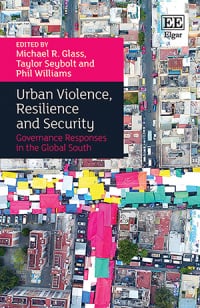

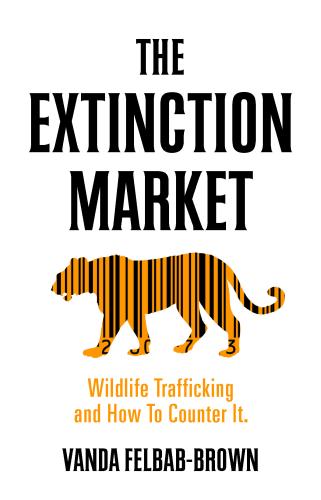
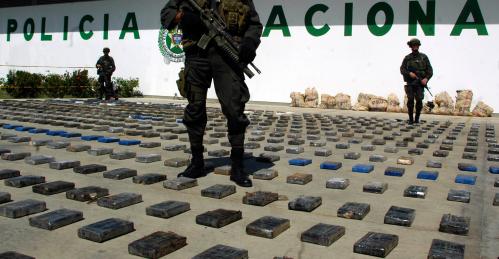
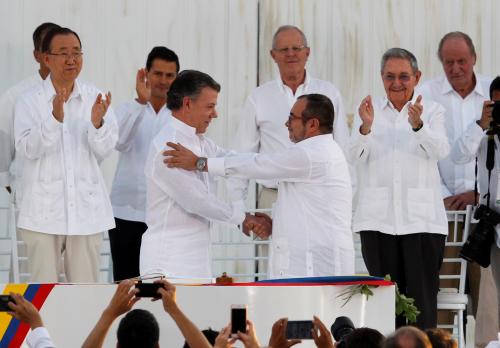
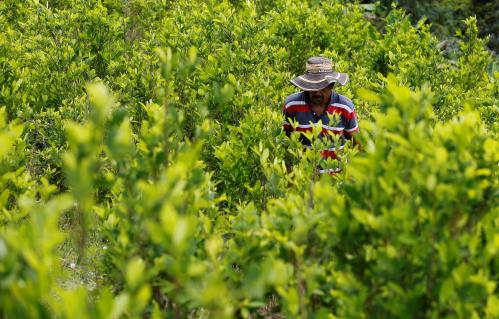

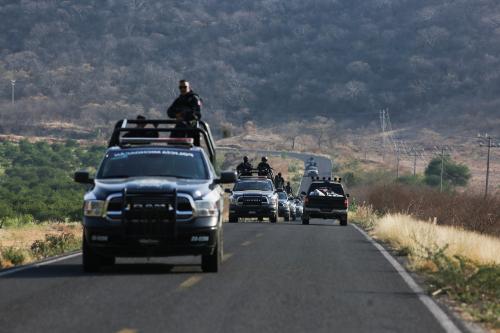

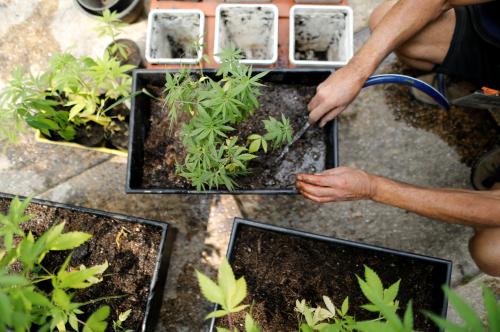
Commentary
What Colombia can learn from Thailand on drug policy
May 4, 2017